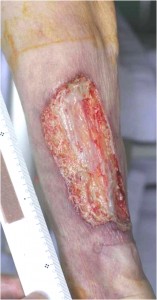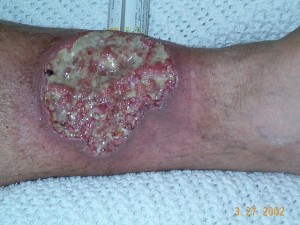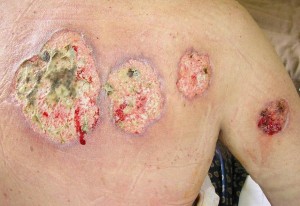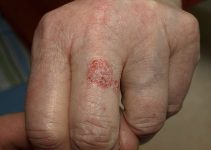What is Pyoderma gangrenosum?
Page Contents
- 1 What is Pyoderma gangrenosum?
- 2 What causes Pyoderma gangrenosum?
- 3 Pyoderma gangrenosum Prevention
- 4 How prevalent is Pyoderma gangrenosum in the United States?
- 5 Can Pyoderma gangrenosum cause death?
- 6 Who is at risk of attack by Pyoderma gangrenosum?
- 7 What are the Pyoderma gangrenosum symptoms?
- 8 The Pyoderma gangrenosum variants
- 9 Treatment for Pyoderma gangrenosum
- 10 Pyoderma gangresnosum treatment for small lesions
- 11 Pyoderma gangrenosum treatment for bigger lesions
- 12 What are the complications of Pyoderma gangrenosum?
- 13 Pyoderma gangrenosum Pictures
Pyoderma gangrenosum or gangrenosum pyoderma refers to serious but rare disease of the skin in which painful pustule or nodule breaks down and then forms ulcer that enlarges progressively.
The name, Pyoderma gangrenosum is related to that way in which the ulcers appear and look like. They have surface that is purulent (pyoderma) and edge that is blue-black in color (gangrenosum).

Picture 1 – Pyoderma Gangrenosum
About 30% of the patients that develop this condition have history of serious trauma on the skin. Pyoderma gangrenosum may be easily confused with some other conditions that present similar symptoms. These other conditions include skin infections, vasculitis, trauma, diabetes skin complications, malignancy, and collagen vascular diseases.
What causes Pyoderma gangrenosum?
The exact Pyoderma gangrenosum causes are not clearly known. It is however believed that immune system deregulation in general and alterations of the neutrophil chemotaxis in particular are the major pyoderma gangrenosum causes. Trauma on the skin oaf people suffering from this condition may lead to the development of wounds and lesions that are difficult to heal.
In most cases, the gsngrenosum pyoderma develops at the site of provisos injury, cut or other skin trauma. Most patients are very able to notice that there is something unusual once the pyoderma gangrenosum begins to develop because the wounds and lesions associated with the condition are very slow to heal. They may also produce purplish or bluish secretion and exude offensive smell.
Pyoderma gangrenosum Prevention
Because the causes of pyoderma gangrenosum are not very well known, it is not possible to prevent or avoid it.
How prevalent is Pyoderma gangrenosum in the United States?
Generally speaking, pyoderma gangrenosum is rare in the United States. It occurs in only one among 100,000 people in a year.
Can Pyoderma gangrenosum cause death?
Death from pyoderma gangrenosum is very rare but this does not mean that it cannot cause it. The death may not be directly caused by pyoderma gangrenosum but because of the diseases or complications that are associated with the disease.
Death may also occur as a result of the therapy treatments that may sometimes involve the use of complex or simultaneous medical procedures and drugs. Most patients complain of pain and they may be tempted to take narcotics to reduce it. This condition may cause problems of healing of wound especially after invasive surgery like for example breast construction or face lift.
Who is at risk of attack by Pyoderma gangrenosum?
Pyoderma gangrenosum can attack any person of any age but it is very common in the persons that are aged 40 years and older. Children may also be affected but it is very rare because their total cases combined account for between 3 and 4% of all the total cases.
Adolescents and teens may also be affected. All the American races seem to be equally affected by this condition. The condition also affects people of all sexes but there seem to be some higher prevalence in women.
What are the Pyoderma gangrenosum symptoms?
In most cases, pyoderma gangrenosum symptoms begin and develop as though it is a reaction to an insect bite. It may develop as a lesion that has a small red pustule or papule but it may change in to bigger lesion that is ulcerative pyoderma gangrenosum. Most patients think that they might have been bitten a poisonous insect like a scorpion or spider.
Most people will complain of pain at the site of pyoderma gangrenosum. The patients may also experience general unwell feeling (malaise) and arthralgias (severe pain of the body joints).
The pyoderma gangrenosum may also develop as a result of an underlying condition like diabetes or lupus. If the pyoderma gangrenosum is as result of underlying condition, the pyoderma gangrenosum treatment should involve treating the lesions as well as treating the condition that is causing or aggravating it. Most patients suffering from this condition develop systemic illness either before, during or after the positive diagnosis of the same.
Pyoderma gangrenosum is closely related but not caused by Crohn disease, ulcerative colitis, regional enteritis and inflammatory bowel disease. It is also associated with polayrthritis that is characterized by pain in the joints. It is also associated with disorders and diseases like monoclonal gammopathies and leukemia. It is recommended that patients suffering from pyoderma gangrenosum undergo thorough medical check of pyoderma gangrenosum symptoms to confirm or out rule these other diseases that may aggravate it.
What should you do when you experience any of these symptoms?
Once you show or experience any symptoms of this condition you should consult a dermatologist as soon as possible. Early pyoderma gangrenosum diagnosis and proper medical intervention measures are the surest ways of dealing with the condition.
Though you may find some suggested home therapies for treating the condition over the internet, it is highly recommended that you take the long and of course the expensive option of seeking proper medical care. You should not take gamble with your health. The pyoderma gangrenosum may be the symptoms of another underlying condition.
The Pyoderma gangrenosum variants
There are two main variants of the pyoderma gangrenosum; the classic pyoderma gangrenosum and the atypical pyoderma gangrenosum. Before going in to the details, it is good to know that the classic pyoderma gangrenosum mostly develops on the legs while the atypical pyoderma gangrenosum mostly develops on the hands.
CLASSIC PYODERMA GANGRENOSUM: this condition is characterized by deep ulceration that has violaceous border which is in most cases overhanging over the head of the ulcer. If the classic pyoderma gangrenosum develops around the stomach it is referred to as peristomal pyoderma gangrenosum. Peristomal pyoderma gangrenosum may be confused with wound infection or irritation resulting from the appliance.
ATYPICAL PYODERMA GANGRENOSUM: this is characterized by juicy vesiculopustular component. This is especially at the border; it is erosive and ulcerated on the superficial part. In most of the cases, the lesions of this nature develop on the hands surface. It may also develop on the face or the fore arms extensor parts.
This form of gangrenosum pyoderma can also occur on the genital parts. It is occurs on the male penis it is referred to as penile pyoderma gangrenosum. If it attacks the female genital parts it is referred to as vulvar pyoderma gangrenosum. This condition is very different from the sexually transmitted diseases and it may be confused with them in most cases. Patients suffering from Crohn disease may develop scrotum pyoderma gangrenosum.
There is an intraoral form of gangrenosum pyoderma that is commonly referred to as pyostomatitis vegetans. It mainly develops in those patients that suffer from inflammatory bowel disease. Upon ocular examination, there may be evidence of extracutaneous neutrophilic disease and this has also been reported in the liver, bones and the lungs.
There may the involvement of other systems of organs in the patients suffering from pyoderma gangrenosum and this will manifest as sterile neutrophilic abscesses. There may also be involvement of the gastro intestinal tract, heart, eyes and the central nervous system.
Treatment for Pyoderma gangrenosum
Even though pyoderma gangrenosum is not life threatening in most cases, patients are advised to consult a dermatologist for advice on pyoderma gangrenosum diagnosis and the best treatment.. The ulcers and lesions of can be cultured or swabbed so as to test for any infections that may be present.
Biopsies may be required for pyoderma gangrenosum diagnosis or out rule other conditions that in most cases accompany the condition.
If there is infection that is accompanying the pyoderma gangrenosum then the patients should be put on the right treatment for that condition. If for example the condition is caused by bacteria the patient should be put on antibiotics. It is however very important to note that pyoderma gangrenosum is not solely caused by bacteria and antibiotics so should not be used for treatment of pyoderma gangrenosum unless there is another infection by bacteria.
Pyoderma gangresnosum treatment for small lesions
The smaller or less severe pyoderma gangrenosum can be treated with:
- Injections and steroid creams
- Compression bandaging
- Anti-inflammatory medications. These may be oral or creams that are applied on the ulcers.
- Dressing by use of hydrocolloids or silver sulphadiazine cream.
Pyoderma gangrenosum treatment for bigger lesions
The larger lesions may be treated by the intense therapy comprising of one or more of the following
- Corticosteroids: this is the best treatment for pyoderma gangrenosum. It is very effective when it is given in the required doses and applied correctly as required. They have the effect of preventing the development of new lesions. At the first few days (or weeks depending on the severity of the condition), high doses of prednisolone may be needed.
- The patient can be given from 60 to 200 milligram per day. Pulse therapy by use of (IV) methylprednisolone that is administered intravenously at doses of 1 gram per day for a duration of between 3 and 5 days may also be used in the treatment.
- Sulfa drugs: these include sulfapyridine, dapsone and sulfasalazine.
Other drugs that may be used in the treatment of pyoderma gangrenosum include:
- 5-aminosalicylic acid
- 6-mercaptopurine
- Adalimumab
- Alefacept
- Benzoyl peroxide
- Chlorambucil
- Clofazimine
- Colchicine ( in low dose)
- Cyclophosphamide
- Cyclosporin
- Etanercept
- Infliximab
- Methotrexate
- Minocycline
- Mofetil
- Mycophenolate mofetil
- Nicotine
- Plamapheresis
- Sodium cromoglicate
- Tacrolimus
- Tacrolimus ointment
- Thalidomide
Hyperbaric oxygen therapy: Hyperbaric oxygen therapy has also been used in the treatment of Pyoderma gangrenosum..
Surgery: Surgery may also be used in Pyoderma gangrenosum treatment but it poses the risk of redeveloping Pyoderma Gangrenosum. It should thus be used at the same with immunosuppressant drugs.
Skin grafts: skin grafts may also be used to repair or replace the damaged tissues as result of this condition.
What are the complications of Pyoderma gangrenosum?
If left untreated pyoderma gangrenosum wounds and lesions are likely to increase in size and become deeper. That may also trigger swelling of the adjacent tissues of the part in which they have affected. Patients may also experience swelling of the lymph nodes and numbness of the hand or leg that is affected.
The patient may also experience severe pain and the wound may bring out offensive smell. After the healing, the scars that will be left may be patient. The scars may also lose some sensitivity especially that of touch. Another potential complication is the development of secondary infection after Pyoderma gangrenosum treatment.
The patient may sometimes be put on antibiotics after treatment to prevent the risk of infection by bacteria. Though it is very rare, the pyoderma gangrenosum may also tend to affect and bring problems of the heart, eyes and other organs of the body.
Though it rarely affects children, if it happens the child is at risk of developing complications or dying than an adult.
The duration or success of treatment of pyoderma gangrenosum is dependent on very many factors. The doctors will assess and treat each individual case separately. It may take weeks months or even several years (when there is recurrence) to completely treat and cure the problem.
Medical data tends to show that there is recurrence in about 50% of the patients that undergo treatment for gangrenosum pyoderma. Most of the patients that develop complications from pyoderma gangrenosum treatment have an underlying condition like diabetes, high blood pressure or lupus that aggravates the condition.
Pyoderma gangrenosum Pictures
Check out some of the pictures of Pyoderma gangrenosum to know more about the condition.

Picture 2 – Pyoderma Gangrenosum Image

Picture 3 – Pyoderma Gangrenosum Photo
References:
http://www.mssurg.net/Team5Conferences/Pyoderma%20Gangrenosum.pdf
http://www.orpha.net/data/patho/GB/uk-PG.pdf


what does a 43 yr old woman with _every___ symptom of this disease, including large deep ulcer as picture 2 above, only deeper with exposed skull that has been present over a year with minimul healing at times, do when doctors say they cannot give ANY diagnosis! To whom and where does she go for answers and life saving treatment? Emory Hospital, Atlanta, did blood tests, MRI &CT Scan, left hospital after 8 nights stay knowing nothing more than when arrived. Please give any information possible.
My heart goes out to you Lanette – i’ve suffered with this ON MY FACE for 20 years – went to probably close to 100 or more dermatologists over the years, who all said i had acne – my current doctor FINALLY seems to have diagnosis correct – his name is Dr. Clifford Berck – located in Great Neck, NY – he has only seen maybe 10 patients in his career with the pyoderma gangrenous & i’m his only case where it is on the face. but he seems to know what he is doing
I believe I have it on my face also it’s been ten years plus I need pictures of pyroderma on the face and in the mouth please thank you Shawn rash ie [email protected]
My husband was diagnosed with Pyoderma and he is in so much pain ! He has 3 spots on his leg and the first dr said it was gout the 2nd dr said a spider bite ! It just continued getting worse so I took him to a dermatologist in our area she said she has only seen maybe 10 cases in the 30 yrs of practice! They are trying different meds and it’s like nothing is working !? This is new to us any ideas on how to maybe get this in remission at least ??
I had pyoderma for five miserable years. I do not have for the past 15 years. I wish to
suggest my treatment to interested doctors.